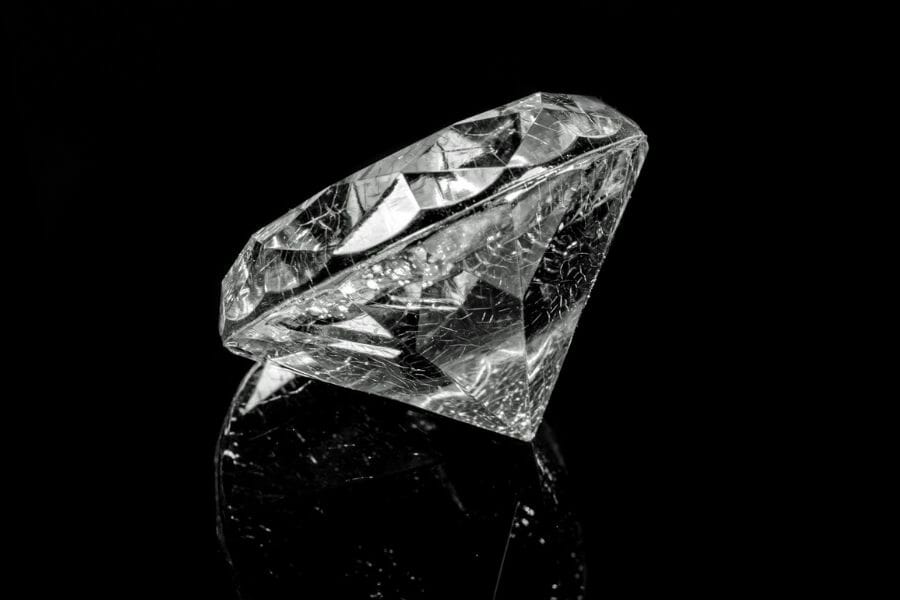White rocks, minerals, and gems are simply elegant! With their brilliant and pristine appearance, they’re sure to turn heads and steal the show.
They’re like diamonds (look up!) in the rough, waiting to be discovered and appreciated for their beauty. And once you find them, you’re sure to be captivated by the allure of these magnificent specimens.
Each one has its own unique story to tell, whether it’s the story of how it was formed deep within the Earth’s crust, or how it’s been shaped and polished by the elements over time. And each one has its own special beauty, too!
So if you’re looking for a little bit of elegance in your life, read on and take a closer look at the world of white rocks, minerals, and gems. You never know what you might discover!
White Gems and Crystals
We rounded up the most interesting white gems that will stun you with their elegance. Take time to stare at their photos so you can see for yourself why they’re so sought after.
Diamond – C
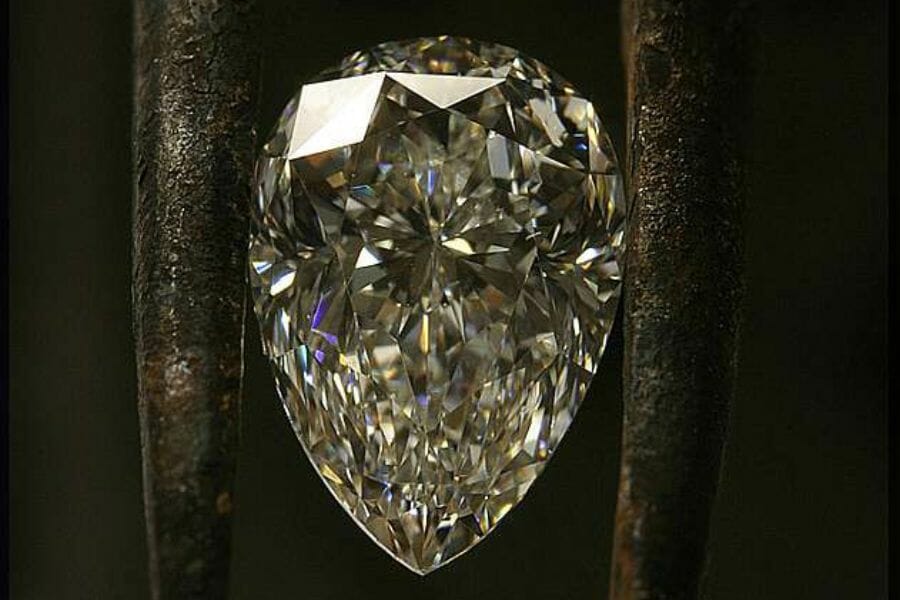
Long considered as the epitome of elegance and sparkle, Diamonds have been coveted by people for centuries. Billions of years ago, these gems were formed deep within the Earth’s mantle. Over time, volcanic eruptions brought them to the surface.
The Greeks and Romans believed that Diamonds were the tears of the gods and that they held magical powers. In the Middle Ages, they were used to adorn royalty and the wealthy. And by the 1400s, the art of cutting and polishing Diamonds had been perfected, making them even more prized and valuable.
But Diamonds aren’t just pretty— they’re also incredibly tough and durable, making them the perfect choice for anything that’s meant to last a lifetime. After all, Diamonds are forever!
Fun Fact In 2007, the Harvard-Smithsonian Center for Astrophysics discovered a "diamond in the sky" with a weight of 10 billion-trillion-trillion carats. This star was named "Lucy", inspired by the Beatles song "Lucy in the Sky with Diamonds". Lucy is located 50 light years away from our planet Earth.
Where Diamond is found
Some of the biggest Diamond mines can be found in Russia, Canada, Australia, and Africa. When it comes to mining them, there’s two types of mines: underground mines and open-pit mines. Diamonds can also be found in alluvial deposits, which are formed when they are transported by water and deposited in riverbeds or on the shoreline. It’s pretty cool to think about the journey these gems have taken from deep within the Earth to become the sparkly treasures we love today!
How you can identify a Diamond
- Color: Diamonds are mostly clear and colorless (like a drop of pure water) or white. There are also “fancy colored Diamonds” that come in pink, blue, green, yellow, and brown. These are rare and valuable, and their colors can range from pale to deep and intense.
- Hardness: Diamond is known for its exceptional hardness, which makes it a popular choice for jewelry. It ranks a 10 on the Mohs scale of hardness, making it the hardest naturally occurring material on Earth. Only a Diamond can cut another Diamond!
- Clarity: Diamond’s clarity varies depending on the presence of inclusions, so the Gemological Institute of America uses a six-point scale to grade its clarity, from Included to Flawless. A Flawless Diamond has no visible inclusions or blemishes when viewed under 10x magnification.
- Refractive index: Diamond has one of the highest refractive indices of any natural material, which is what gives it a unique and beautiful sparkle. It has an unmatched ability to capture and reflect light, making it appear bright, sparkling, and beautiful.
- Specific gravity: Diamond has a relatively high specific gravity, so it’s denser and heavier. This gem is able to hold its weight and maintain its shape because of its unique crystal structure and chemical composition.
Goshenite – Be3Al2(Si6O18)
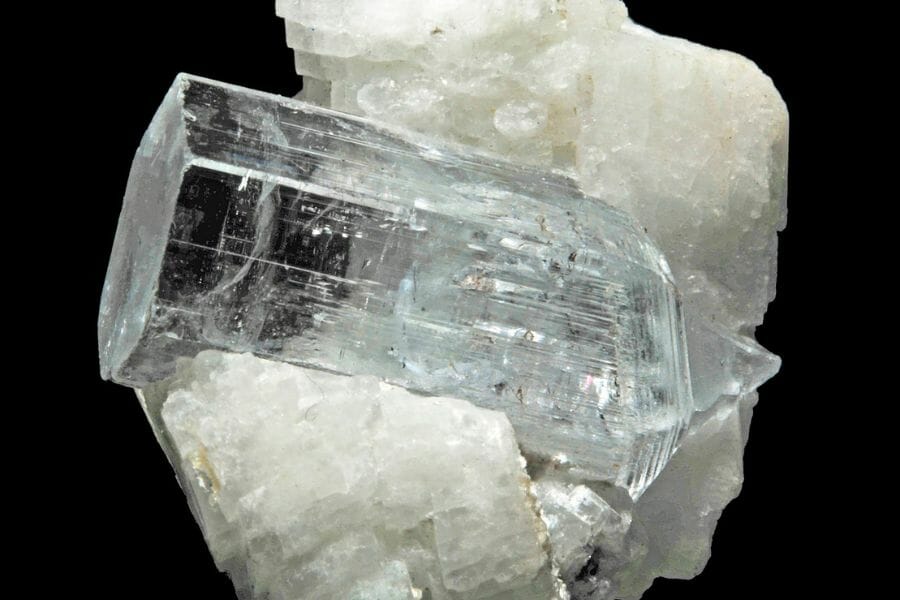
Goshenite, also known as “white beryl,” is a clear, colorless vgem that’s commonly found in many parts of the world. This stunning gemstone has been used for centuries for its beauty, rarity, and durability.
The ancient civilizations of Greeks and Romans have long used Goshenite. These early cultures prized this gem for its beauty, and they used it to create elegant jewelry and ornamental objects.
One of the things that makes Goshenite so special is its clarity and brightness. Unlike many other gemstones that have inclusions, it is known for its transparent and sparkling qualities, making it a beautiful choice for those who are after understated elegance.
Fun Fact Because of its awesome transparency, Goshenite was used in the manufacture of eye glasses and lenses. Talk about beauty with a purpose!
Where Goshenite is found
Goshenite can be found in various parts of the world, including Brazil, the US (mainly in Maine), and Madagascar. It’s also been found in Russia, Afghanistan, and Pakistan. But while this gem can be found on several continents, its not as well-known and as commonly found as other varieties of beryl. Its rarity is what makes it all the more valuable and special.
How you can identify a Goshenite
- Color: Goshenite is known for its clear, colorless appearance. It’s referred to as “white beryl” due to its bright and transparent qualities. This clear, brilliant color gives it the understated elegance it exudes.
- Hardness: Goshenite has a hardness of 7.5-8 on the Mohs scale, which is considered pretty tough. This means it’s resistant to scratches and nicks, and durable enough to withstand some pressure and wear and tear.
- Clarity: Goshenite is known for its exceptional clarity and transparency. It has very few inclusions, or if any, they are usually not visible to the naked eye. This high degree of clarity is what gives this gem its brilliant, sparkling appearance.
- Refractive index: Goshenite has a refractive index of 1.57-1.58, which is considered to be on the higher side of the scale. When light enters a Goshenite, it’s bent and split into its component colors, creating a sparkling rainbow-like effect.
- Specific gravity: Goshenite has a specific gravity of 2.67, which is pretty average. This makes it comfortable to wear in jewelry and easy to handle.
Pearl – CaCO3
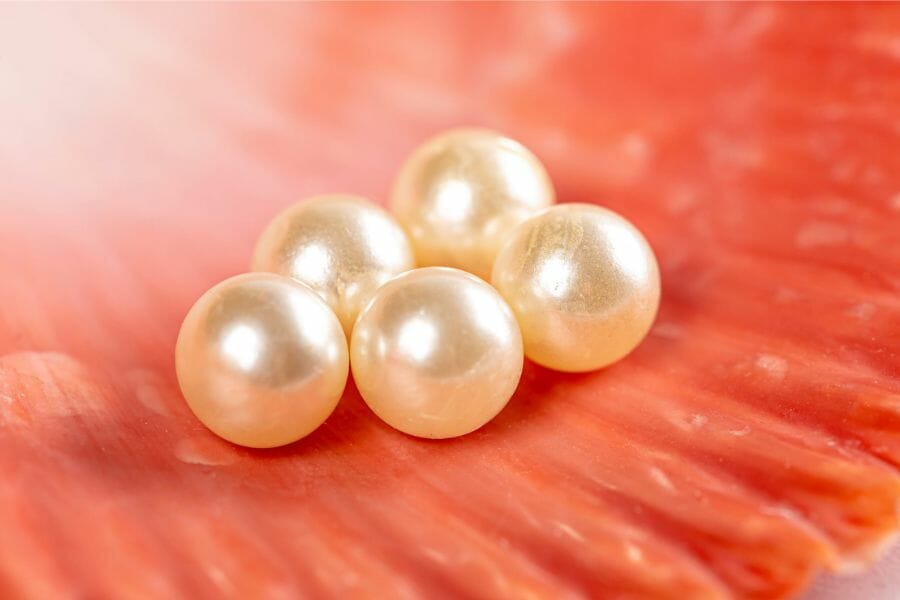
Pearls have a rich and fascinating history that dates back thousands of years. They were once considered one of the most valuable treasures in the world and were even used as a form of currency. They were highly sought after by royalty and the wealthy, and they were often used to adorn clothing and jewelry.
Pearls are created when an irritant (usually a small piece of sand or a parasite) enters the shell of a mollusk and the mollusk forms layers of nacre around the irritant to protect itself. Over time, this process creates a beautiful, lustrous Pearl.
Today, pearls remain widely used in jewelry. They are often given as gifts to mark special occasions such as graduations, weddings, and anniversaries. Truly a timeless classic!
Fun Fact According to legend, Cleopatra dissolved a Pearl in vinegar and drank it just to show off her wealth. In another version of this story, she dissolved the Pearl in a glass of wine to show Mark Antony her indifference to riches.
Where Pearl is found
Pearls can be found in many different types of mollusks (oysters, clams, mussels, etc.) typically in warm water environments such as the Persian Gulf, Red Sea, and along the coastlines of Australia, Japan, and the Philippines. They can be found in freshwater or saltwater environments, affecting their size, shape, color, and quality. Some Pearls are even farmed, which means they are grown on a controlled oyster farm, rather than being found in the wild.
How you can identify a Pearl
- Color: Pearls come in a variety of colors: from classic white to shades of cream, yellow, pink, purple, and black. Its color depends on the type of mollusk it comes from and where it was formed. Just like our fingerprint, no two pearls are exactly alike.
- Hardness: Pearls are relatively soft compared, with a hardness of 2.5-4.5 on the Mohs scale. They can be easily scratched or damaged if not handled and stored with care.
- Clarity: Pearl has a unique type of clarity that’s different from other gems. It has a soft, milky appearance with a slight translucent quality, which makes it look iridescent and glowing.
- Refractive index: The refractive index of Pearl is pretty low, which means it doesn’t have a lot of “fire” or sparkle when light hits it. Its refractive index ranges from 1.5 to 1.7, which gives it that soft, subtle glow.
- Specific gravity: Pearl’s specific gravity is between 2.60-2.80, which means it is slightly less dense than water. Simply put, it’s somewhat lightweight and floaty!
Moonstone – (Na,K)AlSi3O8
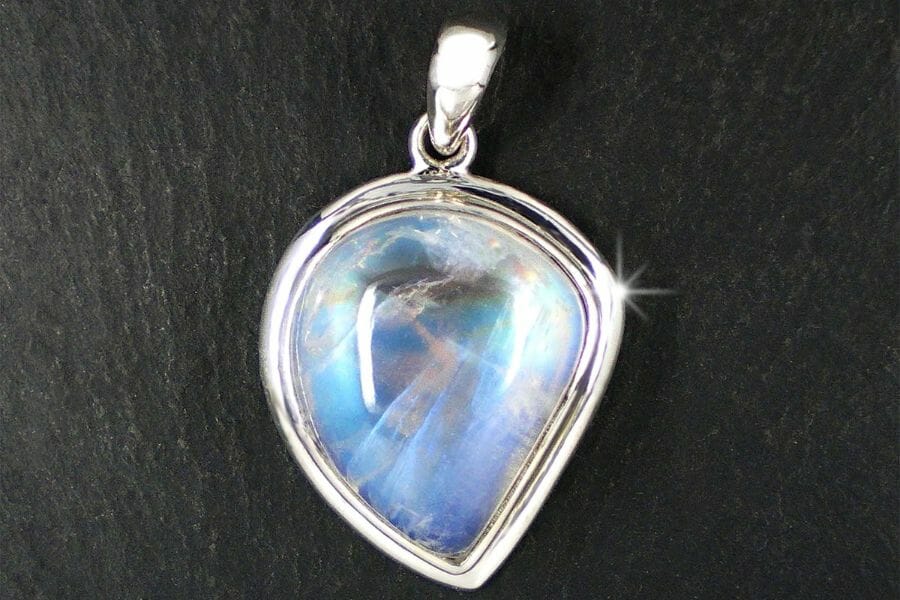
Moonstone is a type of feldspar that’s prized for its unique appearance. It has a soft glow that’s often referred to as a “schiller” effect. This effect creates beautiful play of light and color that changes as the stone is viewed from different angles.
Moonstone has been used for centuries, especially by the ancient Romans and Greeks, who believed that it was formed from solidified moonbeams. It was often used in jewelry and was believed to bring good luck and protection. In Hindu culture, Moonstone was even thought to have a calming energy that could help balance emotions and soothe the soul.
Today, this dreamy gem’s elegant beauty continues to draw attention and attraction!
Fun Fact: For centuries, Moonstone has been said to harvest the energy of the moon. Some cultures believe that it could bring good luck and protection, especially during the night or when the moon was full. Some also believe that Moonstone has the ability to grant wishes, help with decision-making, enhance intuition, and stimulate creativity.
Where Moonstone is found
Moonstone can be found in several countries. Sri Lanka is famous for producing some of the best quality Moonstones with rich colors and intense schiller effects. They’re also found in Brazil and India, where they’re often used in traditional jewelry and spiritual practices. Moonstones are a relatively common gem, but finding one with good color and clarity is a bit more rare. So if you’re looking for one, you might have to do some hunting!
How you can identify a Moonstone
- Color: Moonstone comes in a variety of colors, but the most prized are those with a soft, milky white hue with bluish schiller effect. Some Moonstones can also be found in gray, peach, yellow, and even green.
- Hardness: Moonstone is relatively soft, with a hardness of 6 on the Mohs scale. While it’s still durable enough for everyday wear, it shouldn’t be exposed to harsh chemicals or rough wear.
- Clarity: Moonstone can have varying degrees of clarity, depending on the presence of inclusions. Those with fewer inclusions are considered higher quality and are more valuable. But some inclusions actually add uniqueness and character to a Moonstone.
- Refractive index: Moonstone has a refractive index of 1.50 to 1.53, which is relatively low. This is part of what gives the gem its signature schiller effect, as the light passing through the stone is bent in such a way that it creates a dreamy, ethereal glow.
- Specific gravity: Moonstone has a specific gravity of 2.48 to 2.57. This means that Moonstone is relatively lightweight, making it a great choice for delicate jewelry like pendants and earrings.
Quartz – SiO2
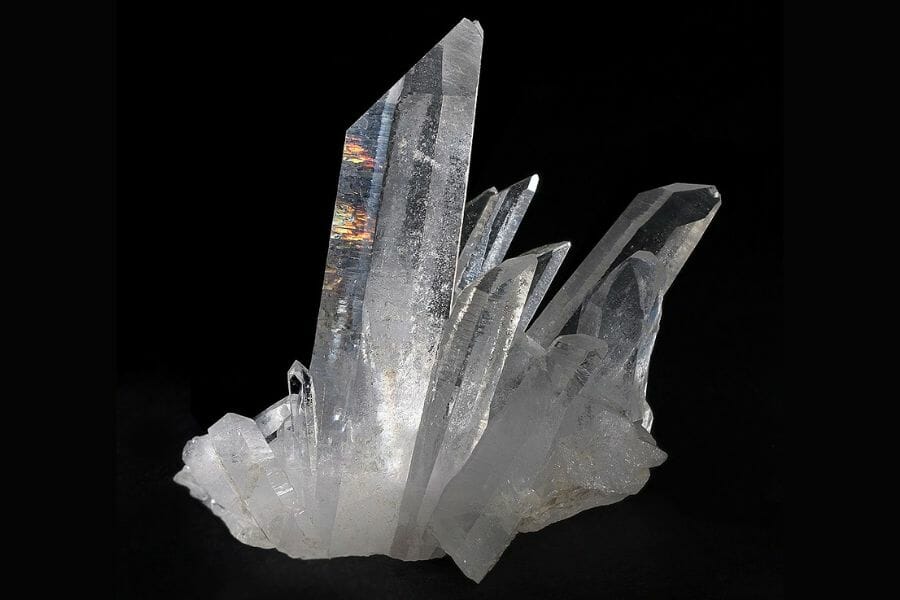
Quartz is a rock-star of a gemstone, and has been used for centuries for all sorts of things— from jewelry to clock-making! It’s clear, glass-like appearance and unique prism-like qualities make it a popular choice for jewelry and other decorative items.
But Quartz wasn’t always just a pretty face. Ancient civilizations like the Greeks and Romans used it in their weapon-making. Quartz has also been used in spiritual practices, such as meditation and energy healing, because it’s believed to have a calming and balancing effect on the wearer.
No matter how it’s used, Quartz has always been valued for its beauty, versatility and durability. No wonder it’s a favorite of gem enthusiasts everywhere!
Fun Fact: Aside from being the second most abundant gem on Earth, did you know that another fun fact about Quartz is that it can actually change color when exposed to ultraviolet light? This is due to impurities that fluoresce, or emit light, when exposed to UV radiation. Imagine a chameleon in crystal form!
Where Quartz is found
Quartz is found all over the world, with major deposits located in Brazil, Madagascar, the US, as well as South Africa, Afghanistan, Australia, and Russia. It’s a common gem, which can be found in many types of rocks and in almost every environment. It’s often found in igneous, metamorphic, and sedimentary rocks, and can even be found in mineral veins, in geodes, and as sand on beaches. With its widespread occurrence and many different forms, Quartz is a versatile crystal that’s easy to obtain.
How you can identify a Quartz
- Color: Quartz comes in a range of colors due to impurities (yellow, pink, purple, gray, brown, and black), but is often known for its clear or white color. Its color varies depending on where it’s found and the conditions under which it was formed.
- Hardness: Quartz’ hardness on Mohs scale is 7, so it can resist scratches from everyday wear and tear. It’s pretty tough and durable, which is why it’s widely used in construction, jewelry, watch-making, electronics, and more!
- Clarity: Some Quartz varieties can be quite clear, while others are more translucent or opaque. But many Quartz specimens contain internal inclusions, bubbles, or other imperfections that may affect its clarity.
- Refractive index: Quartz’ refractive index is around 1.54, which is pretty high. It’s actually the 2nd highest of any gem after diamond, which gives it a nice sparkly look. It’s also why it’s used in things like prisms and lenses.
- Specific gravity: Quartz’ specific gravity is around 2.65, which is considered heavier than an average gem.
Howlite – Ca2B5SiO9(OH)5
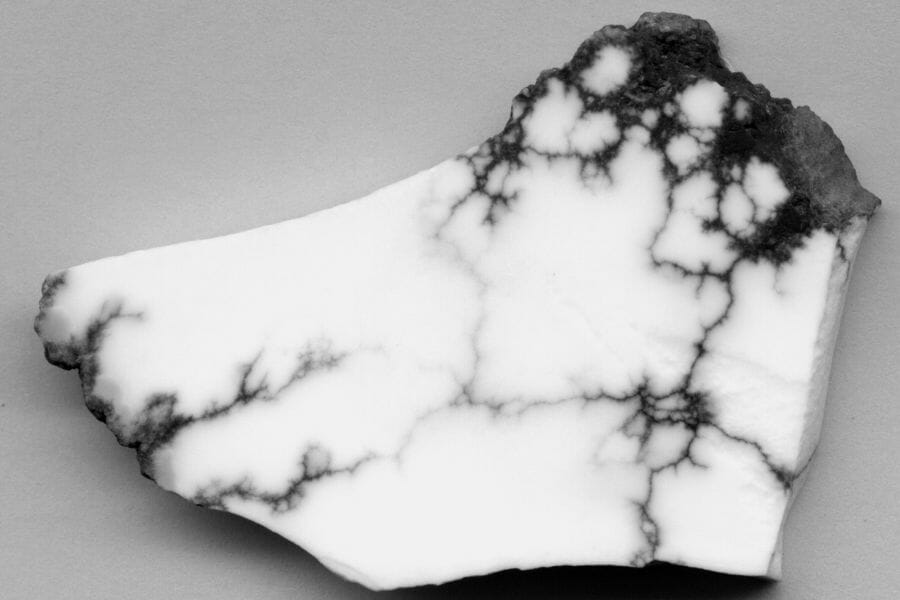
Howlite was discovered in 1868 by a Canadian geologist named Henry How, who named it after himself. With its beauty and lightweight, it’s popular for jewelry-making. It’s been used in all sorts of pieces— from necklaces and bracelets to earrings and even home decor!
Howlite is known for its calming properties, too. People believe that wearing it can help reduce stress, anxiety, and even insomnia. It’s said to help promote peace, positivity, and serenity, making it a popular choice for spiritual practitioners and meditation enthusiasts.
All in all, if you’re looking for a new, fun addition to your jewelry collection or just want to get your hands on a unique gem, Howlite is definitely worth checking out!
Fun Fact:
Want the look of other expensive gemstones without breaking the bank? Howlite is your guy! Did you know that it can be dyed to look like turquoise, ivory, lapiz lazuli, opal, or tiger's eye? A perfect choice for jewelry lovers!Where Howlite is found
Howlite is found in various countries such as the US, Canada, Italy, Germany, and Mexico. It’s mostly found in its white form and is often discovered in its natural state in large deposits. Overall, Howlite is a common gem and can be found in many regions across the world, making it easily accessible to gemstone enthusiasts and jewelry makers.
How you can identify a Howlite
- Color: Howlite is commonly known for its white color with black or grey veins, giving it a unique, marbled appearance. It can sometimes appear in shades of cream or light yellow, too.
- Hardness: Howlite’s is considered a soft stone, with a rating of 3.5-4.5 on Mohs scale. It can be scratched easily and is not suitable for use in anything that’ll undergo frequent wear and tear.
- Clarity: Howlite’s clarity can vary: it’s often seen as opaque with visible inclusions but can also have translucent areas. It can also sometimes look like it has veins of black or gray, which are actually impurities of magnesium.
- Refractive index: Howlite’s refractive index is 1.54-1.55. It’s a medium refractive gem, which contributes to its unique appearance.
- Specific gravity: Howlite’s specific gravity falls around 2.58 – 2.63, which is considerably lighter than other gems. It tends to be rather porous, which makes it less dense.
White Rocks
If you’ve been stunned by the elegance of the white gems, then you have to get ready to read, this time, about the durable but beautiful white rocks out there!
Chalk – CaCO3
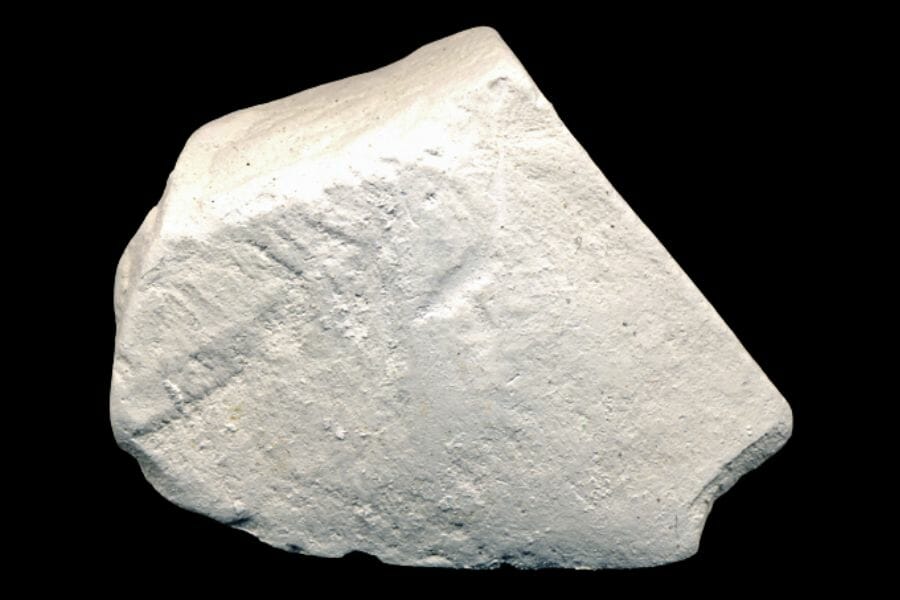
Chalk is a sedimentary rock that forms from the accumulation of microscopic calcium carbonate shells of marine organisms. It has a long and fascinating history (it’s older than dinosaurs!) and has been used for various purposes throughout human history.
In the past, Chalk was used as a writing material, as early forms of Chalk were used by the Greeks and Romans to write on blackboards or walls. It was also used as a material for sculptures and as a component in construction and manufacturing, such as in mortar and concrete.
In recent times, it has been used in agriculture as a soil amendment and neutralizer of soil pH levels. It’s also used in the cosmetic and beauty industry as a mild abrasive in toothpaste and as a filler in some face powders.
Fun Fact: Did you know that the famous symbol of the United Kingdom and the gateway to England, the White Cliffs of Dover, is made of Chalk?
Where Chalk is found
Chalk is found in many places across the world, from England to the US, from France to Australia. It can be found near the coastlines, where it’s been deposited by the sea, or in sedimentary basins, where it’s accumulated in layers over millions of years. It’s even found underground, where it’s been mined for centuries to make chalk for writing and drawing. Chalk is pretty widespread, and you might be surprised how close you are to a deposit of this fascinating rock right now!
How you can identify a Chalk
- Color: Chalk is typically white or light-colored, but some types may have grey, blue, or green hues. Since it’s formed by the accumulation of tiny shells and microscopic skeletons of marine organisms, its color may be influenced by the types of organisms and minerals they contain.
- Hardness: Chalk has a hardness of 2-2.5 on the Mohs scale, so t’s not as hard as some other rocks, but it can still scratch softer ones.
- Clarity: Chalk’s clarity can range from translucent to opaque. But as a sedimentary rock, it’s mostly opaque. It’s not known for it’s clarity, but for its white, chalky appearance and soft texture.
- Refractive index: The refractive index of Chalk varies depending on its composition, but it’s typically low, ranging from 1.5-1.6. This can make Chalk appear cloudy or hazy.
- Specific gravity: Chalk’s specific gravity falls within 2.0-2.7 range. This range is considered light to moderate for rocks.
Coquina
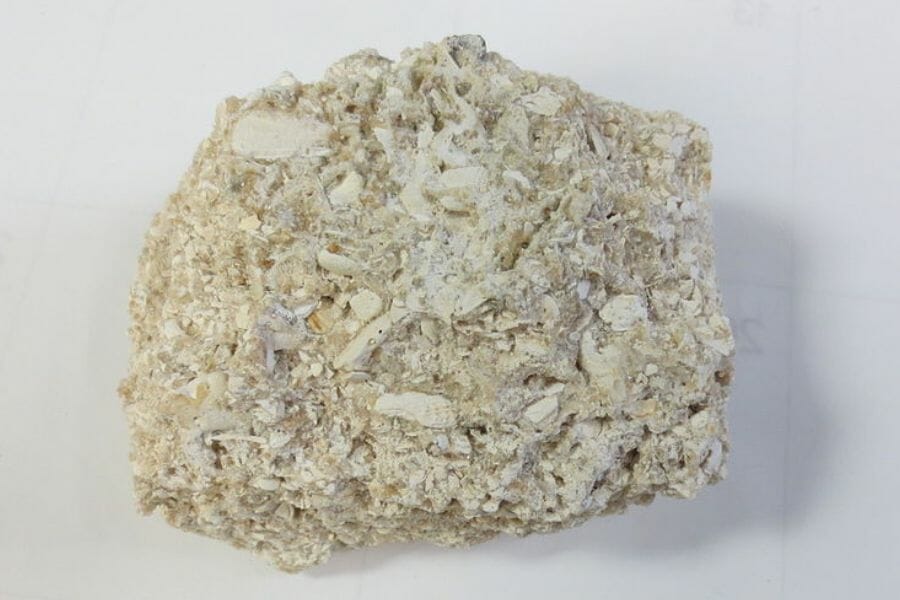
Coquina was first discovered in Florida and the Caribbean. It’s known for its unique texture, made up of tiny shell fragments that are often visible to the naked eye. It’s also prized for its natural beauty, as well as its durability and resistance to erosion.
Coquina has been used for centuries to build structures like forts and churches, and even for sculpture. It’s relatively soft compared to other rocks, making it easy to work with, but it hardens when exposed to air and moisture over time, which gives it its strength.
This rock is also valued for its ability to absorb water, making it an excellent material for landscaping. Whether you’re building a structure or simply adding some character to your yard or aquarium, Coquina is a captivating rock that’s definitely worth a second look!
Fun Fact: Coquina is often called the "shell stone" because of the shell fragments that formed it. This makes it a very lightweight and porous rock. But don't be fooled! This rock is immensely strong, too. In fact, in 1702, the Castillo de San Marcos in St. Augustine, Florida was built with Coquina walls that helped it withstand attacks from cannons.
Where Coquina is found
Coquina is found in various coastal locations across the world, especially in regions with abundant shell deposits, such as Florida in the US and other Caribbean island. It’s also found in countries like Spain, Greece, and some African countries.
How you can identify a Coquina
- Color: Coquina is usually a light off-white to yellow-brown color. Its color varies slightly depending on the location it was formed. It has tiny bits of shells or other organic materials that give it a speckled appearance.
- Hardness: Coquina’s hardness varies, but it’s generally at 2-3 on the Mohs scale. Although it’s a soft rock, it hardens when exposed to air and moisture over time.
- Clarity: Coquina’s clarity can vary. The tiny fragments of shells give it a somewhat translucent appearance but with a lot of visible cracks and shells.
- Specific gravity: Coquina’s specific gravity varies depending on its composition, but it typically ranges from 2.2 to 2.7, which is considered lightweight compared to most other rocks.
Limestone – CaCO3
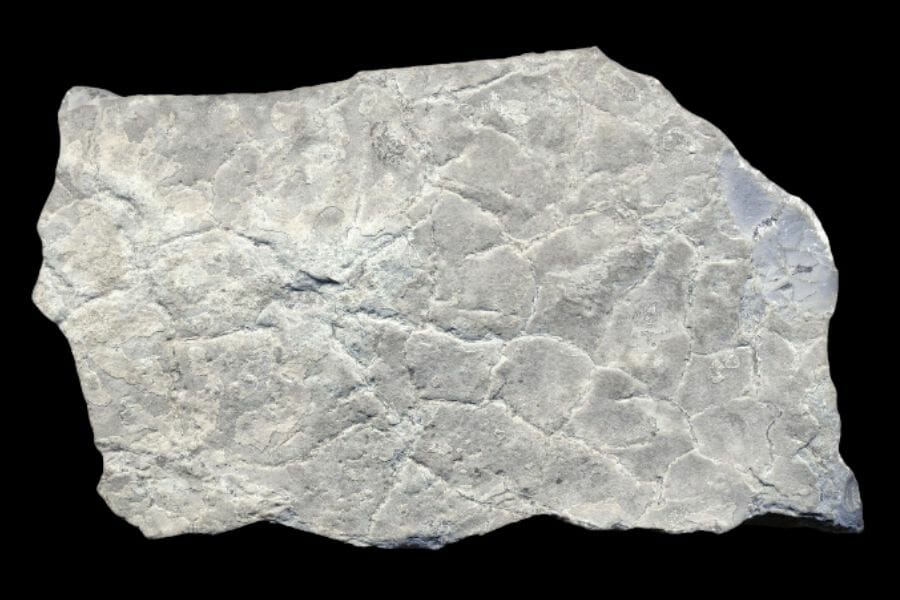
Limestone is a sedimentary rock formed from the accumulation of shells, coral, and algae. It has been used for thousands of years in construction, agriculture, and industry. The Egyptians used it as a building material for the pyramids, while the Romans used it to build their famous aqueducts and structures like the Colosseum.
In agriculture, Limestone is added to soil to neutralize its acidity and improve plant growth. In industry, it’s used as a raw material for the production of cement and lime, which is used in paper, steel, and sugar production.
Limestone is also valued for its beauty, with many historic buildings and monuments like the Lincoln Memorial and the Empire State Building made out of it. It’s also a popular choice for flooring and kitchen countertops due to its durability. Versatile is an understatement for Limestone!
Fun Fact:
Some Limestone formations contain fossils, making it popular among rock collectors and paleontologists. Who wouldn't love finding a preserved sea creature in their kitchen countertop?Where Limestone is found
Limestone is found in many places all over the world, including the US, Canada, Brazil, Mexico, Germany, Spain, Italy, France, England, and Russia. It’s found in big deposits near the Earth’s surface. Limestone is a versatile and widely available natural resource, making it a valuable resource in many regions.
How you can identify a Limestone
- Color: Limestone’s color varies from white to gray, beige, yellow, and even blue. It can also contain impurities, like iron and magnesium, that give it a variety of hues. Its color depends on where it’s found, how it’s formed, and what minerals are present in it.
- Hardness: Limestone’s hardness is 3-4 on Mohs Scale. Its softness makes it easier to carve and shape, so it’s still commonly used in construction and interior design. It can also be crushed into powder and used as a filler in many products like paint, rubber, and plastics.
- Clarity: Limestone’s clarity can range from translucent to opaque, depending on the amount of impurities present. It can also be affected by the way it’s been formed and its type.
- Refractive index: Limestone’s refractive index generally ranges from 1.48-1.5, which means it’s light-scattering properties are low and it doesn’t sparkle as much as other rocks.
- Specific gravity: Limestone’s specific gravity ranges from 2.3 to 2.7. It’s generally heavy and dense, but can also be porous in some cases.
Caliche – NANO3
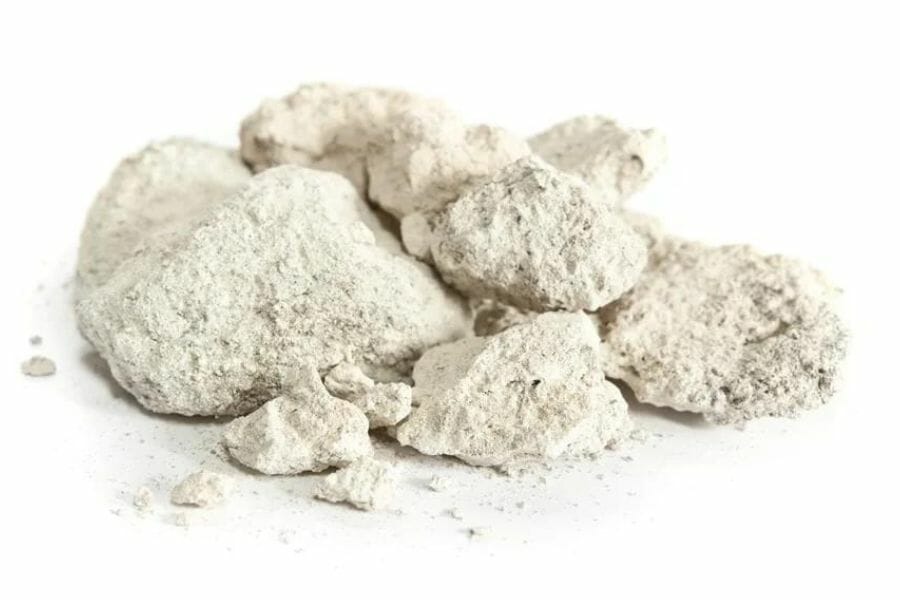
Also known as “calcrete”, Caliche is a type of sedimentary rock that’s made up of calcium carbonate and calcium sulfate minerals. It’s formed when water rich in calcium and sulfates rises to the surface and then evaporates, leaving behind a layer of calcite.
Caliche has been used for a variety of purposes throughout history, including as a building material and as a fertilizer. It was also used by ancient civilizations to make cement, as well as for ornamental purposes in jewelry and art.
Caliche is valued for its durability and strength, as well as for its ability to hold and retain water, making it useful for agriculture.
Fun Fact
It's not just beautiful, versatile, and strong— Caliche is also cool and fun! It has been used in the production of tequila spirit, as its calcium carbonate helps to neutralize the harsh flavors of the agave plant. Don't forget this the next time you take a sip of your tequila!Where Caliche is found
Caliche is mostly found in arid or semi-arid regions, such as the deserts of the southwestern US, Mexico, South America, and Australia. Because it’s so durable and abundant in dry areas, Caliche has been used for a variety of purposes, such as building roads, homes, and walls. It’s also been mined for the minerals it contains, like nitrogen and potassium, which are valuable for agriculture. So if you’re ever out exploring a desert and come across a hard, white layer just below the surface, chances are you’ve stumbled upon some Caliche!
How you can identify a Caliche
- Color: Caliche’s color can range from white to pinkish-red, yellowish to light grey or even brown, depending on its mineral content. Its color can be quite uniform or vary in intensity within the same deposit.
- Hardness: Caliche’s hardness is around 3 on Mohs scale. It’s relatively soft, but it may have harder mineral inclusions that can raise its overall hardness. Its hardness can also be influenced by pressure and temperature during its formation.
- Clarity: As an earthy deposit, Caliche appears opaque and doesn’t have clarity to it.
- Specific gravity: Caliche’s specific gravity varies depending on its composion, but typically falls in the range of 2.0 to 2.7.
Marble – CaCO3
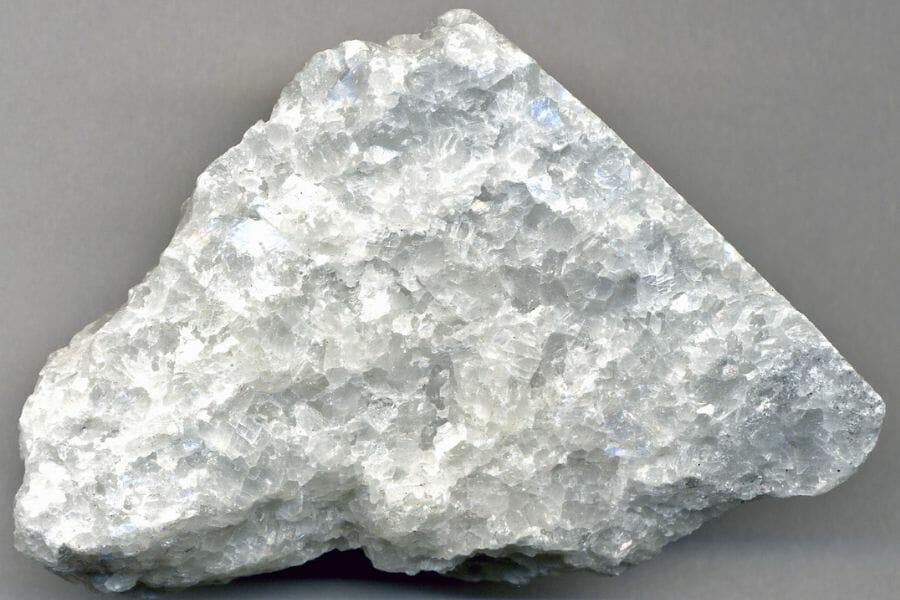
Marble is a type of metamorphic rock that’s formed from heat and pressure, causing it to recrystallize and form a new rock. For centuries, it’s been valued for its beauty, durability, and versatility.
Marble sculptures from ancient civilizations are still around today, showing how well this rock can withstand the test of time. Ancient Greeks and Romans also used it to build temples, palaces, and public baths.
Marble’s popularity continued throughout the Renaissance, with famous artists using it to create some of the world’s most famous sculptures. It was also used to build famous landmarks such as the Taj Mahal, St. Peter’s Basilica, and the Lincoln Memorial.
Fun Fact
Just like a snowflake, no two pieces of Marble are exactly the same! So if you've got a piece of Marble in your house, maybe as your kitchen countertop or bathroom vanity top, then you've got a one-of-a-kind work of natural art!Where Marble is found
Marble is found all over the world in countries like Italy, Spain, Greece, China, India, and the U.S. In the U.S., it’s found in the states of Vermont, Georgia, and Texas. It’s also found in other countries like Turkey, Iran, and Afghanistan. The Carrara region in Italy is even famous for its white Marble used by famous artists like Michelangelo!
How you can identify a Marble
- Color: Marble come in white, black, grey, green, pink, blue, and yellow, just to name a few. Its colors are due to the presence of minerals and impurities, which can create unique patterns and swirls.
- Hardness: Marble’s hardness is rated at 3 on Mohs scale, which means it’s a soft rock, making it easy to carve and shape. But it’s still durable enough for many uses, like flooring, countertops, and sculptures.
- Clarity: Marble’s clarity is generally described as translucent to transparent, with a smooth and uniform surface. Some marble may have impurities, inclusions, or veining which can affect its overall clarity and appearance.
- Refractive index: Marble’s refractive index is typically between 1.5 and 1.7, which means it bends light at a moderate amount and has a moderate level of brilliance.
- Specific gravity: Marble’s specific gravity is typically 2.5-2.8, which is a bit heavier than an average rock. This also means that it’s more solid, making it ideal for anything that requires stability and support.
White Minerals
Oozing with elegance — that’s how we best describe the white minerals we listed below. Just see for yourself!
Goosecreekite – Ca[Al2Si6O16] · 5H2O
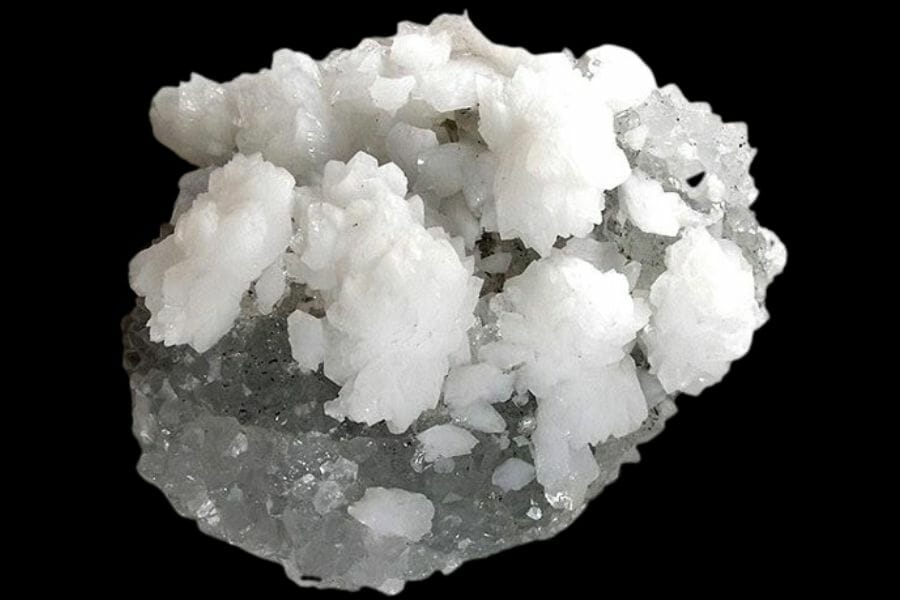
Goosecreekite is relatively new to the geological world. Discovered in 1961 in Goose Creek Mine in Virginia, it’s a rare mineral with a unique composition of iron and manganese oxides.
Despite being new, Goosecreekite has already found a place in the hearts of collectors and mineral enthusiasts. It’s valued for its rarity and unique appearance, as well as its scientific importance.
Although still not widely used, Goosecreekite has been used in a few unique ways. Some people have used it as a decorative rock, while others have used it in jewelry and other decorative objects. Indeed, a great conversation piece and starter!
Fun Fact:
One of the reasons Goosecreekite is of interest to collectors and mineral enthusiasts is that its structure has resemblance to mountains and caves. Just look at its picture here!Where Goosecreekite is found
Goosecreekite is found in hydrothermal veins and contact metamorphic zones. It occurs in several places across the globe, but it is most commonly found in the Virginia, USA, in a region called Goose Creek. It’s a rare mineral and only a few specimens have been found.
How you can identify a Goosecreekite
- Color: Goosecreekite is a white to brownish-yellowish colored mineral, with tints of other colors. Its coloration is caused by the presence of iron, magnesium, and other elements in its crystal structure.
- Hardness: Goosecreekite’s hardness ranges from 4 to 4.5 on Mohs scale, which makes it relatively soft. It can be scratched by a knife, but won’t break easily.
- Clarity: Goosecreekite’s clarity varies and can range from transparent to opaque. Its clarity also depends on the amount of inclusions present within it.
- Specific gravity: Goosecreekite’s specific gravity has been reported to be around 2.6-3.0, which is relatively heavy for a mineral.
Anhydrite – CaSO4
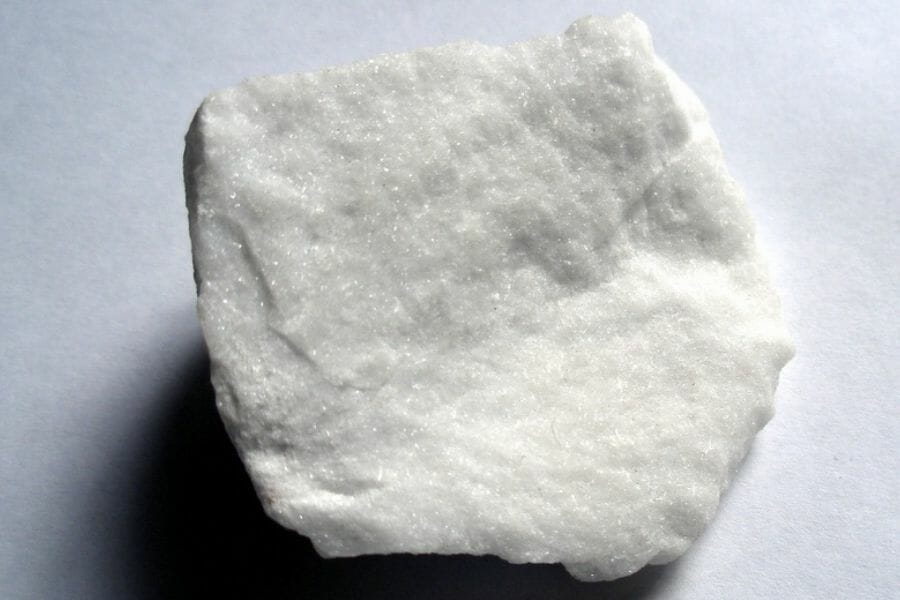
Anhydrite is a mineral that’s been around for eons, and it’s got a pretty interesting history! It was formed by the evaporation of sea water, and is made up of calcium sulfate without any water molecules. It’s been used in many ways over the years, from making plaster of Paris to being used as a soil conditioner.
One of the most fascinating uses of Anhydrite is in the construction industry. It’s often used as a backing for floor tiles and wall tiles due to its low absorption rate and its ability to support heavy loads. Its strength and durability is what makes it so valued in the construction world.
With its unique and elegant formations, it’s easy to see why Anhydrite is often used in jewelry making, too. With all it’s different uses, you might have some Anhydrite in your home without even knowing it!
Fun Fact: Did you know that Anhydrite can change into gypsum when it absorbs water? The reverse is also possible. Gypsum can turn into Anhydrite when it's dehydrated. How cool is that?!
Where Anhydrite is found
Anhydrite can be found in many places around the world, but its most common locations are in evaporite deposits that form in seas, lakes, and other bodies of water that eventually dry up. These deposits are most often found in arid and semi-arid regions, where the climate is dry and evaporation is high. Some of the most notable places where it can be found are the Mediterranean region, parts of Europe and Asia, and certain regions of the Americas, including Mexico and the southwestern US. Anhydrite can also be found in underground mines and caverns, where it forms as a result of chemical reactions between sulfates and other minerals.
How you can identify an Anhydrite
- Color: Anhydrite’s color is usually white, light blue, light gray, or light brown. However, impurities can cause it to appear different hues.
- Hardness: Anhydrite’s hardness varies. On Mohs scale, it usually measures between 3-3.5, which means it’s a soft mineral.
- Clarity: Anhydrite’s clarity can range from translucent to opaque. It can also have some impurities, but it’s usually clear enough for you to see light thru it. Its crystal structure contributes to its clarity. If an Anhydrite is too cloudy, it may have been formed in an environment with too many impurities, which makes it less valuable.
- Refractive index: Anhydrite’s refractive index is between 1.520-1.529. It’s still low enough so you can see right through it without it appearing too blurry!
- Specific gravity: Anhydrite has a specific gravity of 2.9 to 3.0, which is relatively low. This means that it may not be the most durable mineral for jewelry and other decorative applications.
Kernite – Na2B4O6(OH)2·3H2O
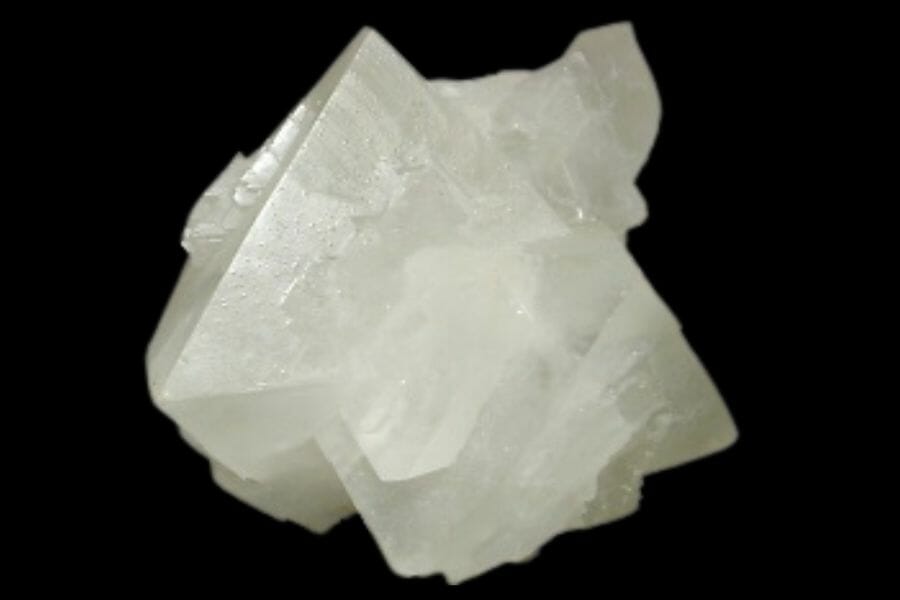
Kernite was discovered back in the 1800s and, since then, it’s been a valuable resource for many things! It’s named after the Kern River Valley in California where it was originally found.
Kernite is used in the production of borax, which is used for cleaning and production of glass, ceramics, and textiles. It’s also used in the production of herbicides, insecticides and as a flux in metallurgical processes. Kernite is valued for its high boron content, which is a very important element that’s in high demand.
In recent years, Kernite has also become an important source of lithium, which is a metal that’s used in batteries and other electronic components. This makes this mineral even more valuable, especially in the fast-growing market for renewable energy.
Fun Fact:
While Kernite is a jack-of-all-trades when it comes to its many uses, it's beauty also captivates! Did you know that it glows a bright red color under ultraviolet light? This glow is due to the europium in the crystal structure of Kernite. This makes it a popular choice for mineral collectors and hobbyists. Who knew Kernite could be so cool!Where Kernite is found
Kernite is mostly found in deserts, specifically in the USA’s Mojave Desert and in the Atacama Desert of Chile. It’s a mineral that’s often associated with borax deposits. The mineral is also found in other countries, like Turkey, Iran, and Russia, but the deposits in the Mojave Desert are considered to be the largest in the world. Kernite can also be found in Australia and several other countries in South America and Africa.
How you can identify a Kernite
- Color: Kernite is commonly pale pink, pale yellow, or white. Some specimens can have a pale orange or reddish-brown coloration due to the presence of impurities like iron.
- Hardness: Kernite hardness is around 2 to 3 on Mohs scale. It’s pretty soft and can be scratched with a fingernail, that why it’s not used in jewelry, but it has other uses due to its softness like in the production of chemicals.
- Clarity: Kernite is usually transparent to translucent depending on the presence of impurities. No set standard exists for clarity in this mineral, but specimens with higher clarity are typically more valued than those with less.
- Refractive index: Kernite has a refractive index of about 1.47-1.49, which is relatively low but still enough to create a modest amount of sparkle when hit by light.
- Specific gravity: Kernite’s specific gravity, on average is about 2.6-2.8, which is relatively low. This means it’s light-weight compared to it’s size.
Epistilbite – CaAl2Si6O16 · 5H2O
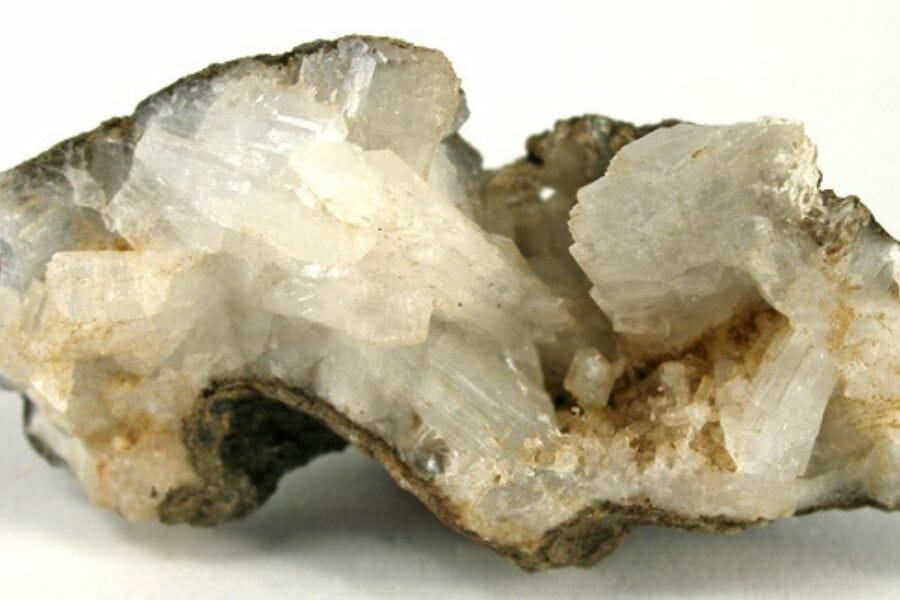
A member of the zeolite group, Epistilbite is found in volcanic rocks and cavities. It’s a rare mineral that has a unique crystal structure. It was first discovered in 1824 in a lava flow near the village of Tolfa, Italy. Since then, it’s been found in various locations including France, Germany, Iceland, and the US.
Epistilbite is not a well-known mineral, but it’s valued for its rarity and beauty. While fascinating to the eyes, this mineral is not typically used for any commercial purposes. However, it remains sought after by mineral collectors.
It’s said to be an excellent mineral for grounding and balancing emotions. It’s believed to help calm the mind and promote a sense of peace and tranquility. Just look at its calming elegance in the photo!
Fun Fact:
Epistilbite was named after the Greek word "epistilbos," which means "capstone." This is because it has a habit of forming thin, cap-like crystals on top of other minerals. So if you come across a mineral that looks like it's wearing a little hat, you might have found yourself some Epistilbite!Where Epistilbite is found
Epistilbite is found in several countries, including USA, Canada, Germany, and Japan. It’s often found in volcanic regions, specifically in hydrothermal vents and in certain types of zeolite deposits. It’s also been found in association with other minerals like chabazite, stilbite, and heulandite, which makes for a colorful and interesting mineral specimen collection!
How you can identify a Epistilbite
- Color: Epistilbite has a light color that ranges from white to pale yellow. It’s got a very subtle hue, like a milky appearance. It can also display a slight bluish tinge, giving it a beautiful and unique look.
- Hardness: Epistilbite’s hardness is typically around 4-5 on Mohs scale. That’s soft enough to be scratched with a fingernail, but still tough enough to withstand most everyday wear and tear.
- Clarity: Epistilbite is transparent to translucent, but its clarity can vary depending on the presence of inclusions or impurities in its crystal structure.
- Refractive index: The refractive index of Epistilbite is between 1.490-1.505, which is considered moderate to low. This means that when light passes through it, it’s bent to a lesser degree, which affects Epistilbite’s brightness and appearance.
- Specific gravity: Epistilbite’s specific gravity is generally around 2.3, which means it’s pretty light compared to other minerals, but still has a good density, so it’s not super delicate.
Laumontite – Ca(AlSi2O6)2 · 4H2O
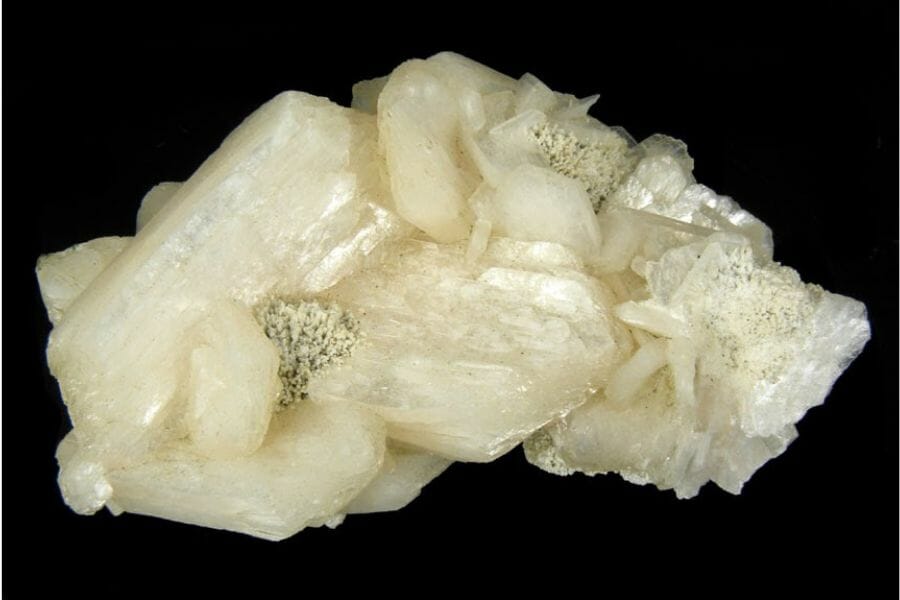
Laumontite is a fascinating mineral that has a rich history and a variety of uses. This mineral is named after French geologist Gilbert Laumont and was first discovered in the 1800s.
Laumontite has a variety of uses, and it’s valued for its unique properties. One of its most notable properties is its ability to absorb and retain water. In construction, it’s used as a lightweight aggregate, while in agriculture, it helps regulate the moisture content of soil.
In addition to its practical uses, Laumontite’s beauty is another quality that makes it valuable. It’s cut and polished to make beads or jewelry, vases, figurines, and other decorative items.
Fun Fact
Laumontite is sometimes refered to as "puffed up zeolite". If you look at the photo above, you'll notice that it has a light, fluffy appearance. Talk about cuteness and elegance all wrapped up in one mineral!Where Laumontite is found
Laumontite is found in various locations worldwide, particularly in volcanic ash deposits, and areas with hot springs, geysers, and fumaroles. In the U.S., it’s found in California and New Mexico, as well as in several countries in Europe, Asia and South America. Laumontite is also commonly found as a secondary mineral in metamorphic rocks and hydrothermal veins.
How you can identify a Laumontite
- Color: Laumontite’s usually colorless or white, but sometimes it can have a yellow or light green hue.
- Hardness: Laumontite has a hardness of 3.5 to 4 on Mohs scale. It’s considered soft and can be easily scratched by a fingernail. This makes it delicate and susceptible to damage, but makes it perfect for carving and decorative purposes.
- Clarity: Laumontite’s clarity can vary, but it’s generally translucent to opaque. Some specimens can have a nearly clear transparency, but more often, it is cloudy or hazy. In general, it does not have a high clarity, making it difficult to see through.
- Refractive index: Laumontite’s refractive index varies between 1.49-1.54, which is not too high and not too low (typical of many silicate minerals). Its low dispersion gives it a slightly cloudy appearance.
- Specific gravity: Laumontite’s specific gravity is typically 2.2-2.4, which is pretty light. This is partly due to its high porosity.
Hydrozincite – Zn5(CO3)2(OH)6
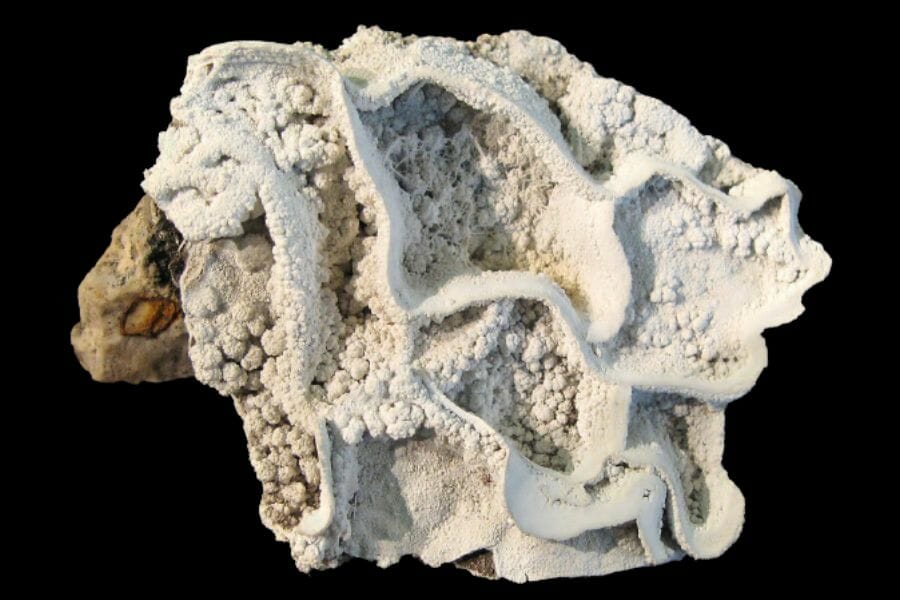
Hydrozincite, a hydrated zinc carbonate mineral, has a long and interesting history. It’s been known since the 1800s and has been used for a variety of purposes.
In the past, Hydrozincite has been used as a pigment and as a source of zinc. It’s also been used in the production of fertilizers and animal feed due to its high zinc content.
Hydrozincite can form in a variety of shapes and forms, including spherical aggregates, botryoidal masses, and fibrous aggregates. Its unique and attractive appearance makes it a sought-after mineral for collectors and mineral enthusiasts today.
Fun Fact
Did you know that Hydrozincite glows? That's right, its' fluorescent! It creates a bright blue glow under ultraviolet light. This is due to the presence of zinc in its chemical structure, which gives it the ability to emit light when exposed to UV radiation. So next time you're at a museum or science center, keep an eye out for this glow-in-the-dark mineral!Where Hydrozincite is found
Hydrozincite is typically found in damp oxidized zinc-bearing ore deposits, as well as in some rare secondary mineral deposits. These deposits can be found all over the world, with significant ones located in the USA, Canada, Australia, and parts of Europe. Simply put, Hydrozincite is a worldwide mineral! Some of its most famous deposits are located in Tennessee, USA, and in the Erzgebirge mountain range in Germany.
How you can identify a Hydrozincite
- Color: Hydrozincite is usually white to light gray or bluish-gray in color. But it can also appear as light yellow, green, and pink. It’s a soft mineral that’s often found as crusty or powdery deposits.
- Hardness: Hydrozincite’s hardness is low: it’s rated 2.5-3 on Mohs scale. It can be easily scratched by everyday items, like a fingernail or a coin. It’s not suitable for jewelry that’s worn daily, as it may get damaged quickly.
- Clarity: Hydrozincite’s clarity can vary from transparent to translucent. Some specimens may appear cloudy or opaque due to the presence of mineral matter or other inclusions.
- Refractive index: Hydrozincite’s refractive index is typically low, around 1.5 – 1.6. It doesn’t reflect light as well as other minerals and has a lower brilliance. The refractive index may vary depending on the conditions in which it was formed.
- Specific gravity: Hydrozincite’s specific gravity is typically 2.5-3.0, which is considered average. This means it has a medium weight for its size compared to other minerals.

